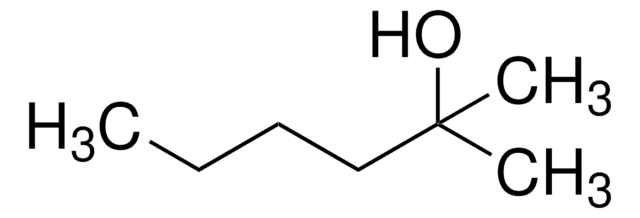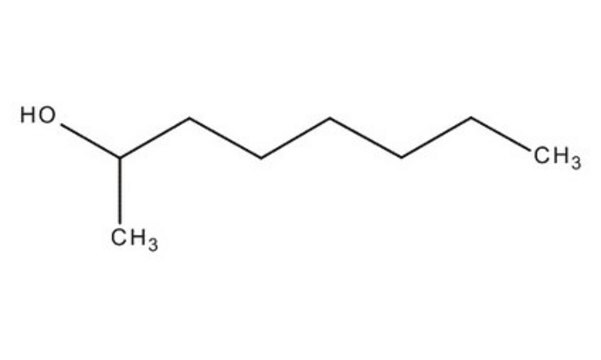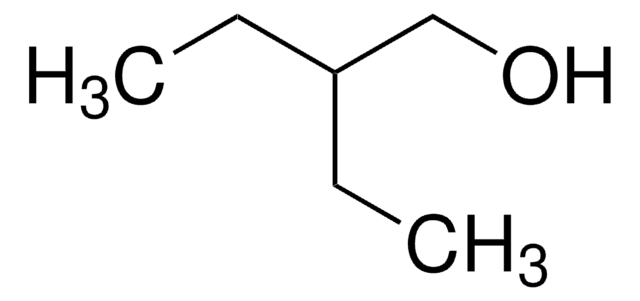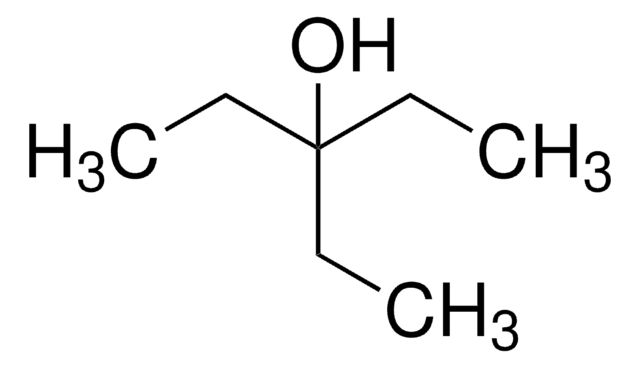All Photos(1)
About This Item
Linear Formula:
CH3(CH2)3CH(OH)CH2CH3
CAS Number:
Molecular Weight:
116.20
Beilstein:
1719067
EC Number:
MDL number:
UNSPSC Code:
12352100
eCl@ss:
39020218
PubChem Substance ID:
NACRES:
NA.22
Recommended Products
Quality Level
Assay
99%
refractive index
n20/D 1.421 (lit.)
bp
66 °C/20 mmHg (lit.)
density
0.821 g/mL at 20 °C
0.818 g/mL at 25 °C (lit.)
SMILES string
CCCCC(O)CC
InChI
1S/C7H16O/c1-3-5-6-7(8)4-2/h7-8H,3-6H2,1-2H3
InChI key
RZKSECIXORKHQS-UHFFFAOYSA-N
Looking for similar products? Visit Product Comparison Guide
General description
3-Heptanol is the main biotransformation product of n-heptane.
Application
3-Heptanol can be used:
- As a solvent to form microenvironments around single-walled carbon nanotubes.
- To prepare substituted pyrimidine derivatives as C1 domain-targeted isophthalate analogs to study their binding affinities towards PKCα isoform.
- As a building block to synthesize 4-(3-adamantan-1-yl-ureido)-butyric acid and cyclohexanecarboxylic acid derivatives as sEH inhibitors.
Signal Word
Warning
Hazard Statements
Precautionary Statements
Hazard Classifications
Acute Tox. 4 Oral - Flam. Liq. 3
Storage Class Code
3 - Flammable liquids
WGK
WGK 3
Flash Point(F)
140.0 °F - closed cup
Flash Point(C)
60 °C - closed cup
Personal Protective Equipment
dust mask type N95 (US), Eyeshields, Gloves
Choose from one of the most recent versions:
Already Own This Product?
Find documentation for the products that you have recently purchased in the Document Library.
Solvatochromic shifts of single-walled carbon nanotubes in nonpolar microenvironments
Silvera-Batista CA, et al.
Physical Chemistry Chemical Physics, 12(26), 6990-6998 (2010)
Carlos A Silvera-Batista et al.
Physical chemistry chemical physics : PCCP, 12(26), 6990-6998 (2010-05-14)
Single-walled carbon nanotubes (SWNTs) are encapsulated with microenvironments of nonpolar solvent, providing a new method to measure the photophysical properties of nanotubes in environments with known properties. Photoluminescence (PL) and absorbance spectra of SWNTs show solvatochromic shifts in 16 nonpolar
Biologically active ester derivatives as potent inhibitors of the soluble epoxide hydrolase
Kim I-H, et al.
Bioorganic & medicinal chemistry letters, 22(18), 5889-5892 (2012)
L Perbellini et al.
Archives of toxicology, 58(4), 229-234 (1986-04-01)
Numerous n-heptane metabolites have been identified and quantified by gas chromatography and mass spectrometry in some tissues and in the urine of Sprague Dawley rats exposed for 6 h to 1800 ppm n-heptane. 2-Heptanol and 3-heptanol were the main biotransformation
Maria Stecklum et al.
In vitro cellular & developmental biology. Animal, 51(2), 183-191 (2014-10-02)
In the present study, purified human cord blood stem cells were co-cultivated with murine hepatic alpha mouse liver 12 (AML12) cells to compare the effect on endodermal stem cell differentiation by either direct cell-cell interaction or by soluble factors in
Our team of scientists has experience in all areas of research including Life Science, Material Science, Chemical Synthesis, Chromatography, Analytical and many others.
Contact Technical Service









